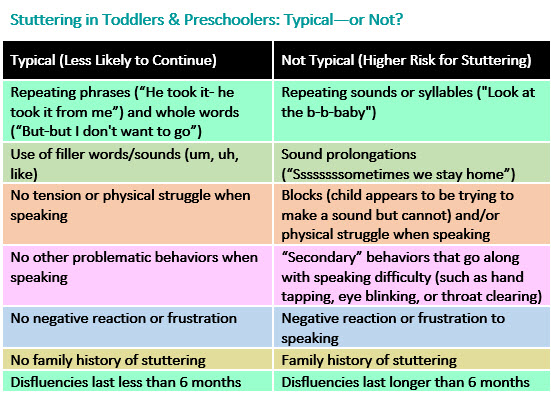As toddlers and preschoolers become increasingly verbal, they may begin to stumble over their words—raising concerns about stuttering. As a parent, how do you know when disfluencies are a normal part of development and when to be more concerned? Read on.
What are Typical Disfluencies?
It is not uncommon for young children to have disfluencies in their speech (e.g., word or phrase repetitions). In fact, about 5% of all children are likely to be disfluent at some point in their development, usually between ages 2 ½ and 5. It is also very typical for a child to go back and forth between periods of fluency and disfluency. Sometimes, this can occur for no apparent reason, but often this happens when a child is excited, tired, or feels rushed to speak.
Learning language rules:
During this time, children are expanding their vocabularies rapidly and learning complex language rules. These rules allow children to change simple messages (“Mommy juice”) into longer, more complicated sentences that require more motor coordination to produce smoothly (“Mommy put the juice in the blue cup”). It’s only natural that there may be some disruptions along the way.
Is It Truly Stuttering?
For most toddlers and preschoolers, most disfluencies go away on their own after a short period of time. In other cases, disfluencies persist and the signs of stuttering become more obvious. Getting professional help early offers the best chances for reducing stuttering. But how can parents tell the difference between typical disfluency that will go away and the early signs of non-typical disfluencies that may indicate stuttering?
Here are some ways to differentiate typical disfluency from stuttering:

If your child is truly stuttering, he or she may hold out the first sound in a word, saying “Ssssssssometimes we stay home,” or repeat the sound, as in “Look at the b-b-b-baby!” In addition, children who stutter often develop other mannerisms such as eye blinking, tense mouth, looking to the side, and avoiding eye contact.
Last Updated 12/27/2016
Source Copyright © 2015 American Academy of Pediatrics and American Speech-Language-Hearing Association
The information contained on this Web site should not be used as a substitute for the medical care and advice of your pediatrician. There may be variations in treatment that your pediatrician may recommend based on individual facts and circumstances.






